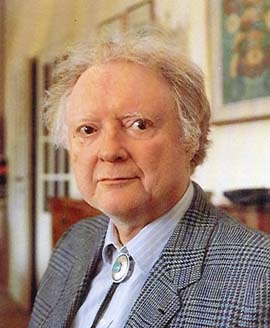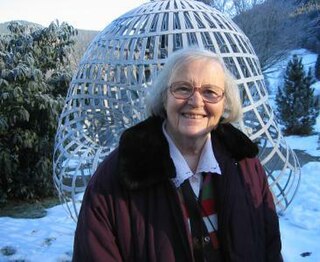
General relativity, also known as the general theory of relativity and Einstein's theory of gravity, is the geometric theory of gravitation published by Albert Einstein in 1915 and is the current description of gravitation in modern physics. General relativity generalizes special relativity and refines Newton's law of universal gravitation, providing a unified description of gravity as a geometric property of space and time or four-dimensional spacetime. In particular, the curvature of spacetime is directly related to the energy and momentum of whatever matter and radiation are present. The relation is specified by the Einstein field equations, a system of second order partial differential equations.
Quantum gravity (QG) is a field of theoretical physics that seeks to describe gravity according to the principles of quantum mechanics. It deals with environments in which neither gravitational nor quantum effects can be ignored, such as in the vicinity of black holes or similar compact astrophysical objects, such as neutron stars.
The Immirzi parameter is a numerical coefficient appearing in loop quantum gravity (LQG), a nonperturbative theory of quantum gravity. The Immirzi parameter measures the size of the quantum of area in Planck units. As a result, its value is currently fixed by matching the semiclassical black hole entropy, as calculated by Stephen Hawking, and the counting of microstates in loop quantum gravity.
In theoretical physics, geometrodynamics is an attempt to describe spacetime and associated phenomena completely in terms of geometry. Technically, its goal is to unify the fundamental forces and reformulate general relativity as a configuration space of three-metrics, modulo three-dimensional diffeomorphisms. The origin of this idea can be found in an English mathematician William Kingdon Clifford's works. This theory was enthusiastically promoted by John Wheeler in the 1960s, and work on it continues in the 21st century.
In theoretical physics, Euclidean quantum gravity is a version of quantum gravity. It seeks to use the Wick rotation to describe the force of gravity according to the principles of quantum mechanics.

The Wheeler–DeWitt equation for theoretical physics and applied mathematics, is a field equation attributed to John Archibald Wheeler and Bryce DeWitt. The equation attempts to mathematically combine the ideas of quantum mechanics and general relativity, a step towards a theory of quantum gravity.
In general relativity, the pp-wave spacetimes, or pp-waves for short, are an important family of exact solutions of Einstein's field equation. The term pp stands for plane-fronted waves with parallel propagation, and was introduced in 1962 by Jürgen Ehlers and Wolfgang Kundt.

Tullio Eugenio Regge was an Italian theoretical physicist.
General relativity and supergravity in all dimensions meet each other at a common assumption:

Causal dynamical triangulation, theorized by Renate Loll, Jan Ambjørn and Jerzy Jurkiewicz, is an approach to quantum gravity that, like loop quantum gravity, is background independent.
The Cartan–Karlhede algorithm is a procedure for completely classifying and comparing Riemannian manifolds. Given two Riemannian manifolds of the same dimension, it is not always obvious whether they are locally isometric. Élie Cartan, using his exterior calculus with his method of moving frames, showed that it is always possible to compare the manifolds. Carl Brans developed the method further, and the first practical implementation was presented by Anders Karlhede in 1980.
The Yilmaz theory of gravitation is an attempt by Huseyin Yilmaz and his coworkers to formulate a classical field theory of gravitation which is similar to general relativity in weak-field conditions, but in which event horizons cannot appear.

In physics, canonical quantum gravity is an attempt to quantize the canonical formulation of general relativity. It is a Hamiltonian formulation of Einstein's general theory of relativity. The basic theory was outlined by Bryce DeWitt in a seminal 1967 paper, and based on earlier work by Peter G. Bergmann using the so-called canonical quantization techniques for constrained Hamiltonian systems invented by Paul Dirac. Dirac's approach allows the quantization of systems that include gauge symmetries using Hamiltonian techniques in a fixed gauge choice. Newer approaches based in part on the work of DeWitt and Dirac include the Hartle–Hawking state, Regge calculus, the Wheeler–DeWitt equation and loop quantum gravity.

The causal sets program is an approach to quantum gravity. Its founding principles are that spacetime is fundamentally discrete and that spacetime events are related by a partial order. This partial order has the physical meaning of the causality relations between spacetime events.
In physics, a pregeometry is a hypothetical structure from which the geometry of the universe develops. Some cosmological models feature a pregeometric universe before the Big Bang. The term was championed by John Archibald Wheeler in the 1960s and 1970s as a possible route to a theory of quantum gravity. Since quantum mechanics allowed a metric to fluctuate, it was argued that the merging of gravity with quantum mechanics required a set of more fundamental rules regarding connectivity that were independent of topology and dimensionality. Where geometry could describe the properties of a known surface, the physics of a hypothetical region with predefined properties, "pregeometry" might allow one to work with deeper underlying rules of physics that were not so strongly dependent on simplified classical assumptions about the properties of space.

Yvonne Choquet-Bruhat is a French mathematician and physicist. She has made seminal contributions to the study of Einstein's general theory of relativity, by showing that the Einstein equations can be put into the form of an initial value problem which is well-posed. In 2015, her breakthrough paper was listed by the journal Classical and Quantum Gravity as one of thirteen 'milestone' results in the study of general relativity, across the hundred years in which it had been studied.

Group field theory (GFT) is a quantum field theory in which the base manifold is taken to be a Lie group. It is closely related to background independent quantum gravity approaches such as loop quantum gravity, the spin foam formalism and causal dynamical triangulation. It can be shown that its perturbative expansion can be interpreted as spin foams and simplicial pseudo-manifolds (depending on the representation of the fields). Thus, its partition function defines a non-perturbative sum over all simplicial topologies and geometries, giving a path integral formulation of quantum spacetime.
In the field of theoretical physics, the Holst action is an equivalent formulation of the Palatini action for General Relativity (GR) in terms of vierbeins by adding a part of a topological term (Nieh-Yan) which does not alter the classical equations of motion as long as there is no torsion,

In theoretical physics, shape dynamics is a theory of gravity that implements Mach's principle, developed with the specific goal to obviate the problem of time and thereby open a new path toward the resolution of incompatibilities between general relativity and quantum mechanics.

Ruth Margaret Williams is a British mathematician at the University of Cambridge. Her research focuses on discrete gravity.







